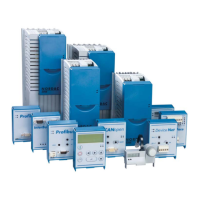
Do you have a question about the nord NORDAC SK 5xxE Series and is the answer not in the manual?
| Category | DC Drives |
|---|---|
| Enclosure rating | IP20 |
| Series | NORDAC SK 5xxE |
| Input voltage | 3-phase 380-480 V AC |
| Control type | Vector control |
| Communication interfaces | CANopen, PROFIBUS DP |
| Protection features | Overcurrent, overvoltage, undervoltage, short circuit, overtemperature |
| Relative humidity | 95% non-condensing |
Guidelines for the installation and cooling of the drive power converter.
Instructions for safe electrical connection of the drive power converter.
Safety and operating instructions for using the drive power converter.
Critical safety and installation guidelines to prevent hazards.
Details on proper installation positioning and ventilation requirements.
Explains the use and components of the optional EMC Kit for compliant wiring.
Information on brake resistors, their types, and electrical data.
Essential guidelines for EMC-compliant wiring of the frequency inverter.
General warnings and requirements for electrical connection.
Detailed instructions for connecting the power unit, including mains and motor.
Guidelines for connecting the motor cable, including length and shielding.
Details on connecting the braking resistor terminals.
Explains DC-coupling of frequency inverters and braking resistor connection.
Overview of terminal blocks and their functions for different device series.
Specific control connection details for SK 5x0E models.
Specific control connection details for SK 5x5E models.
Lists and describes various technology units available for the SK 5xxE.
Details the features and installation of the SimpleBox for basic parameterisation.
Describes the ControlBox for parameterisation, display, and control with data storage.
Explains the ParameterBox for parameterisation, control, and data management with LCD display.
Details parameters for display, parameterisation, administration, and options within ParameterBox.
Describes pre-programmed factory settings and motor data input.
Basic circuitry and parameter adjustments for initial control connections.
Allows selection of one of four available parameter sets.
Sets the time for the frequency to rise from 0Hz to maximum.
Sets the time for the frequency to fall from maximum to 0Hz.
Defines the minimum output frequency when enabled.
Defines the maximum output frequency.
Smooths acceleration and braking ramps for dynamic speed changes.
Accounts for the delayed reaction time of electromagnetic brakes.
Takes into account the electromagnetic brake release time.
Determines how the output frequency is reduced after blocking.
Sets the initial frequency value after enabling the inverter.
Sets the nominal motor frequency, defining the break point for nominal output.
Sets the nominal motor speed for slip calculation and display.
Sets the nominal motor current for current vector control.
Sets the nominal motor voltage to match the mains voltage.
Sets the motor power factor, crucial for current vector control.
Sets or measures motor stator resistance for current vector control.
Affects current for magnetic field generation, influencing load-independent operation.
Affects torque-generating current, load-dependent, for start-up torque.
Increases output frequency to maintain motor speed under load.
Automatically adjusts motor magnetization for optimal efficiency based on load.
Defines parameters for current vector control and linear frequency characteristic curves.
Automatically determines motor data for improved drive characteristics.
Activates speed control with speed measurement via an incremental encoder.
Input for pulse count per rotation of the connected encoder.
P-component of the encoder for proportional amplification of speed control.
I-component of the encoder for eliminating control deviation in speed control.
Current controller for torque current, ensuring precise setpoint maintenance.
I-component of the torque current controller for precise setpoint maintenance.
Sets maximum voltage increase for the torque current controller.
Current controller for field current, ensuring precise setpoint maintenance.
Assigns functions to the analog input for setpoint or control.
Assigns functions to the analog input 2, identical to P400.
Configures the function of output 1 (relay contact K1).
Configures the function of output 2 (relay contact K2).
Configures the function of digital output 3.
Configures the function of digital output 4.
Defines the minimum frequency the FI will not undershoot.
Enables flying start for already rotating motors, e.g., in fan drives.
Resets parameters to factory settings or without bus parameters.
Limits the inverter output current to a set value.
Prevents rapid shutdown by limiting output current via brief switching off.
Monitors output current for symmetry and excitation current.
Lists core parameters for inverter settings, motor data, and basic configuration.
Parameters related to motor specifications and performance characteristics.
Parameters for encoder input, servo mode, and speed control.
Parameters for configuring digital and analog inputs/outputs and bus functions.
Assigns functions to the analog output.
Sets the stop time for the fast stop function.
Detailed table of error codes, texts, causes, and remedies.
General technical specifications including frequency, overload, regulation, and interfaces.
Electrical data for 115V mains devices, including power, current, and fuses.
Electrical data for 230V mains devices, covering various sizes and phases.
Electrical data for 400V mains devices, covering various sizes and phases.
Explains how main and auxiliary setpoints are processed and combined.
Describes the PI process controller for limiting output and scaling.
Details EMC directives, standards, and compliance measures.
Explains conditions leading to reduced output power and its limitations.
